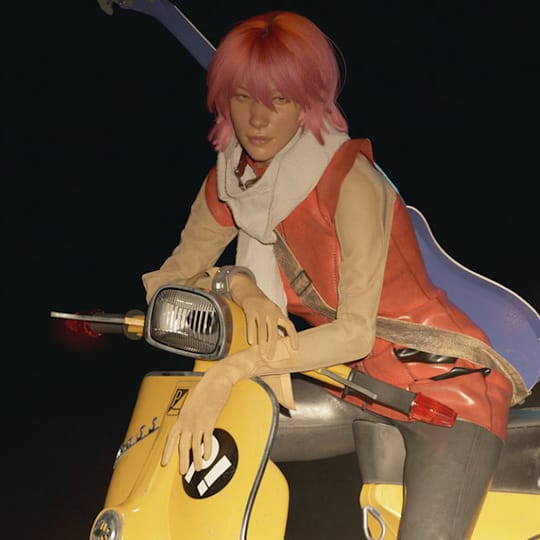A Robot in the headlights: Elvira Trofimova’s dazzling image brings FLCL's Canti and Haruko to life. Find out how V-Ray for Maya helped her create and render it.
There’s no doubt that Elvira Trofimova has a talent for visual storytelling. In her anime character study FLCL Crew, she has rendered the mysterious Haruko, complete with her Vespa scooter and Rickenbacker bass guitar, and the adorable robot Canti. What’s more, she has managed to construct an environment for them that is both believable and mystifying, setting up a scene that enhances their characteristics.
We caught up with Elvira, who let us in on her entire process, giving us valuable tips and tricks on combining several renderings into a powerful composition while hitting tight deadlines. Read on to learn how she used V-Ray for Maya to achieve realistic lighting and textures.
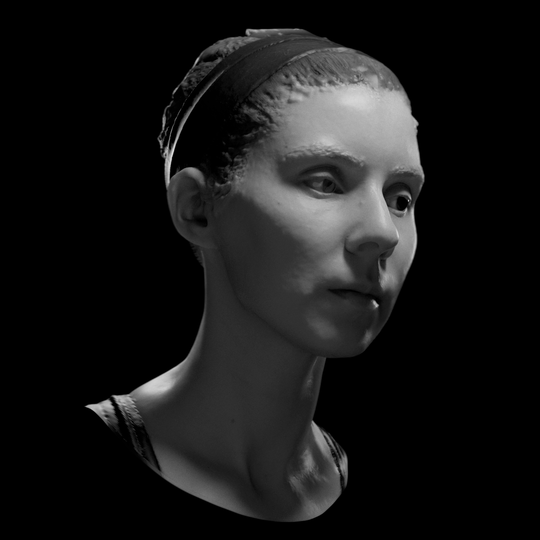
About Elvira “El” Trofimova
Elvira was born in Russia, where she studied traditional art and began her professional career as an artist for social and mobile games in Samara and Moscow. She relocated to New York to work as a concept artist for collectibles, and then studied digital production at Gnomon. Elvira is currently based in LA, working as a 3D character artist at arthouse game development studio Eyes Out on some cool unannounced stuff.
The idea
I’ve been a fan of the FLCL show since I saw it for the first time in early 2000.
And while studying at Gnomon, I enjoyed combining class assignments thematically to have the opportunity to composite them later. FLCL crew was the result of the combination of multiple projects I worked on throughout those two years. The Vespa and Canti were made for Hard Surface 2 class with Max Dayan; the Rickenbacker was modeled for Michael Pavlovich’s Intro to ZBrush before Iwent to Gnomon and later textured for Lighting and Rendering Class with Oded Raz. I sculpted Haruko in ZBrush for Digital Sculpting with James Schauf.
I had all those models waiting for the spotlight, and finally had the chance to combine them all together for the Look Development class with Miguel Ortega. After I gathered all my renders, I pitched this concept:
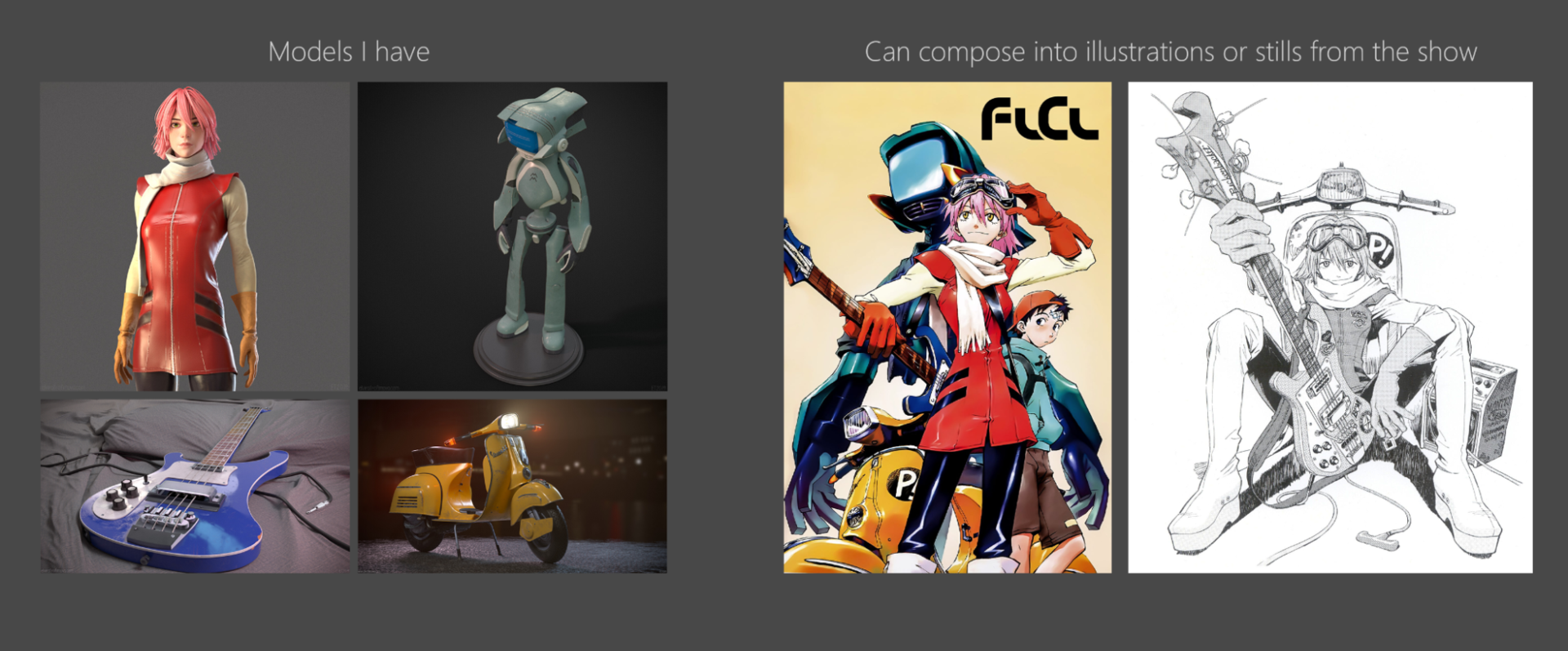
References and composition
I wasn’t exactly sure how I wanted to combine the models, so I went through reference images of the show to gather some more inspiration (always a good excuse to re-watch a show you love!)
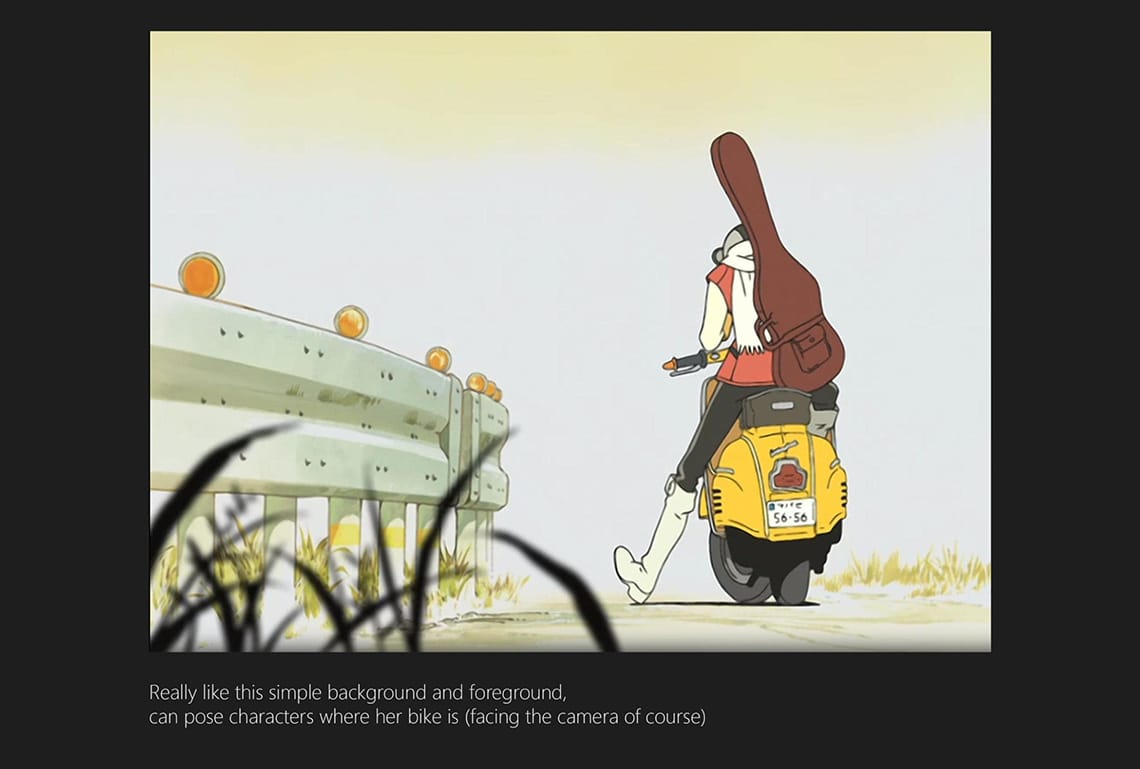
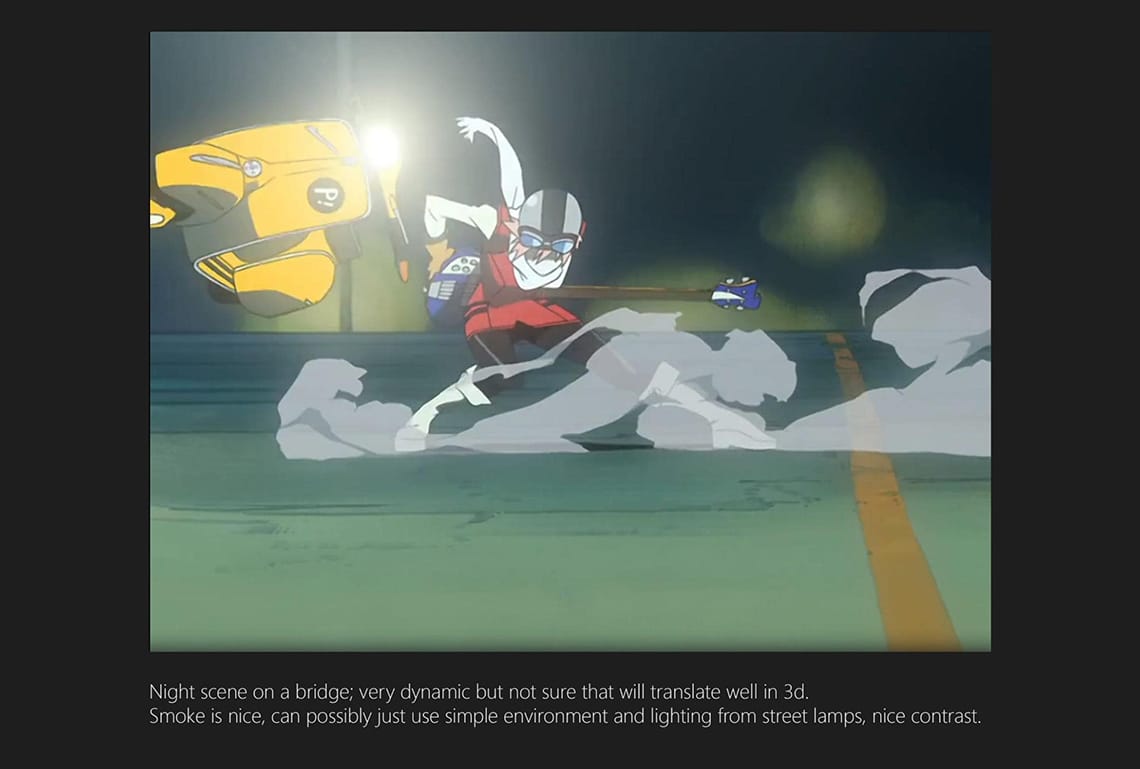
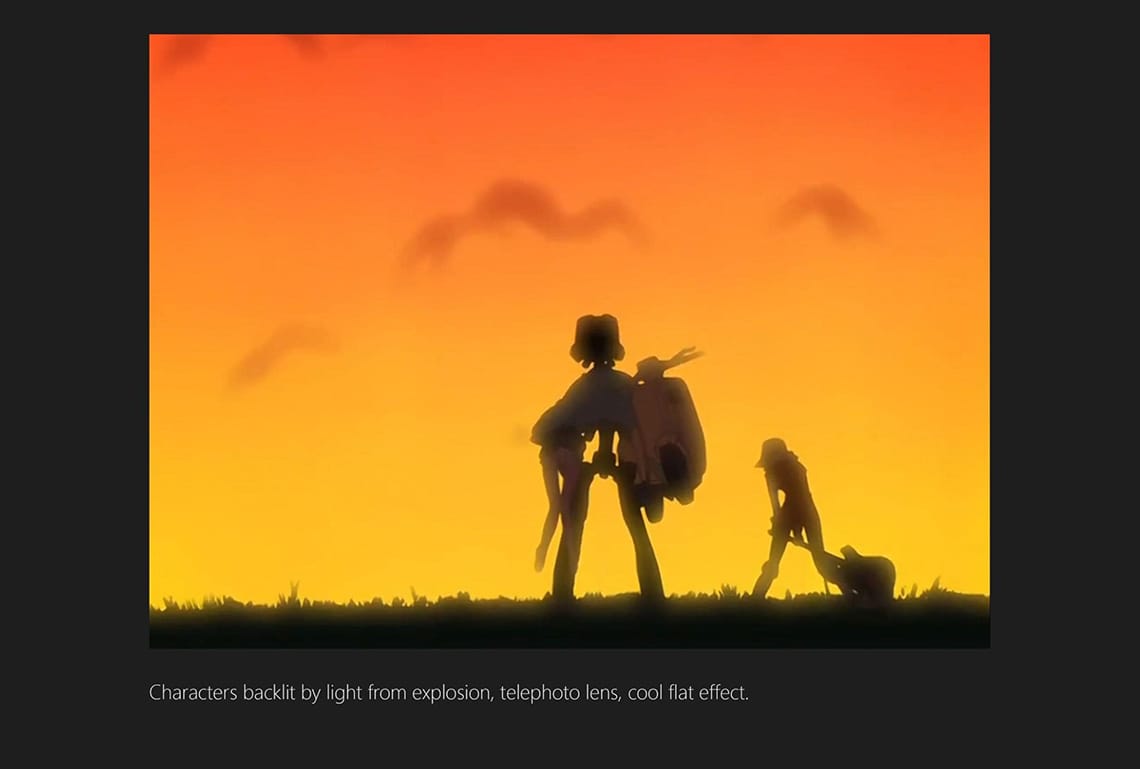
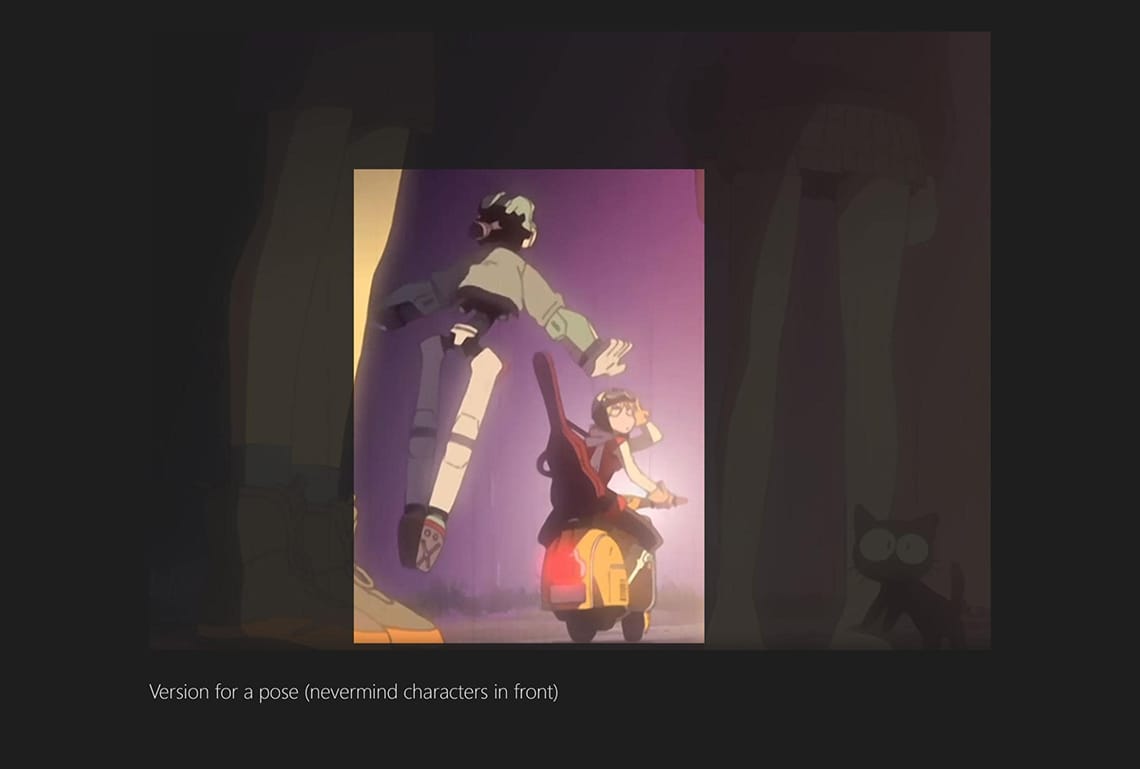
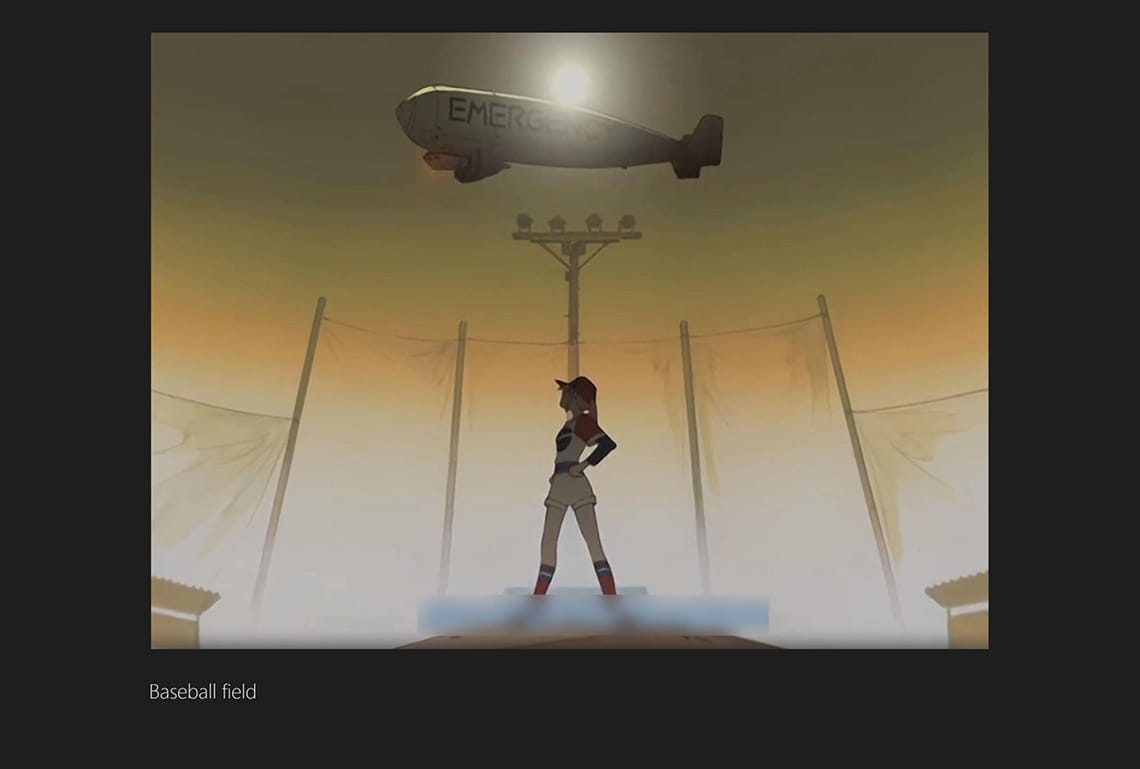
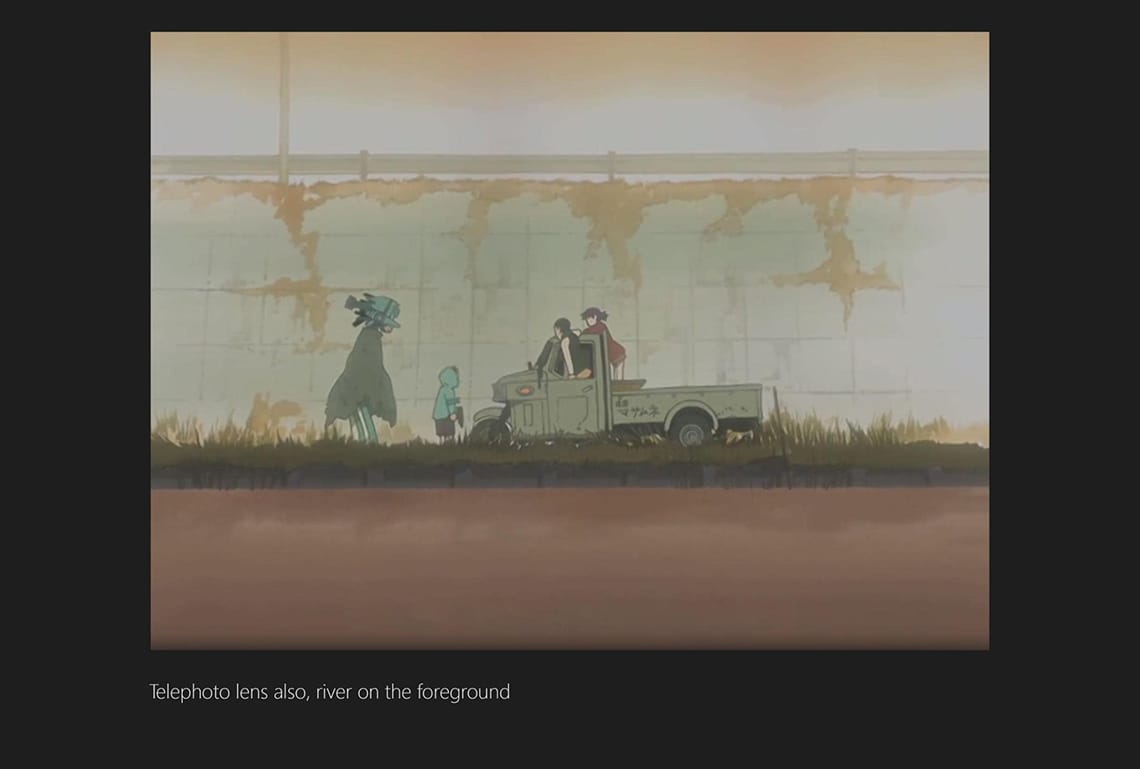
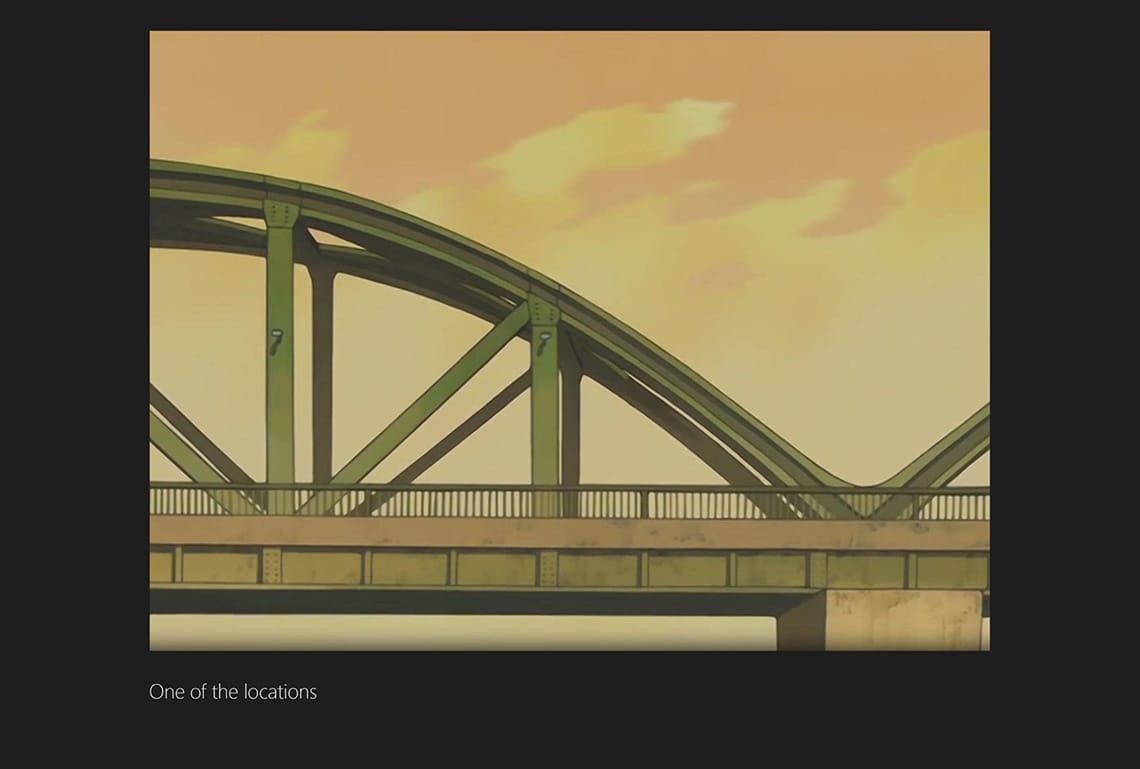
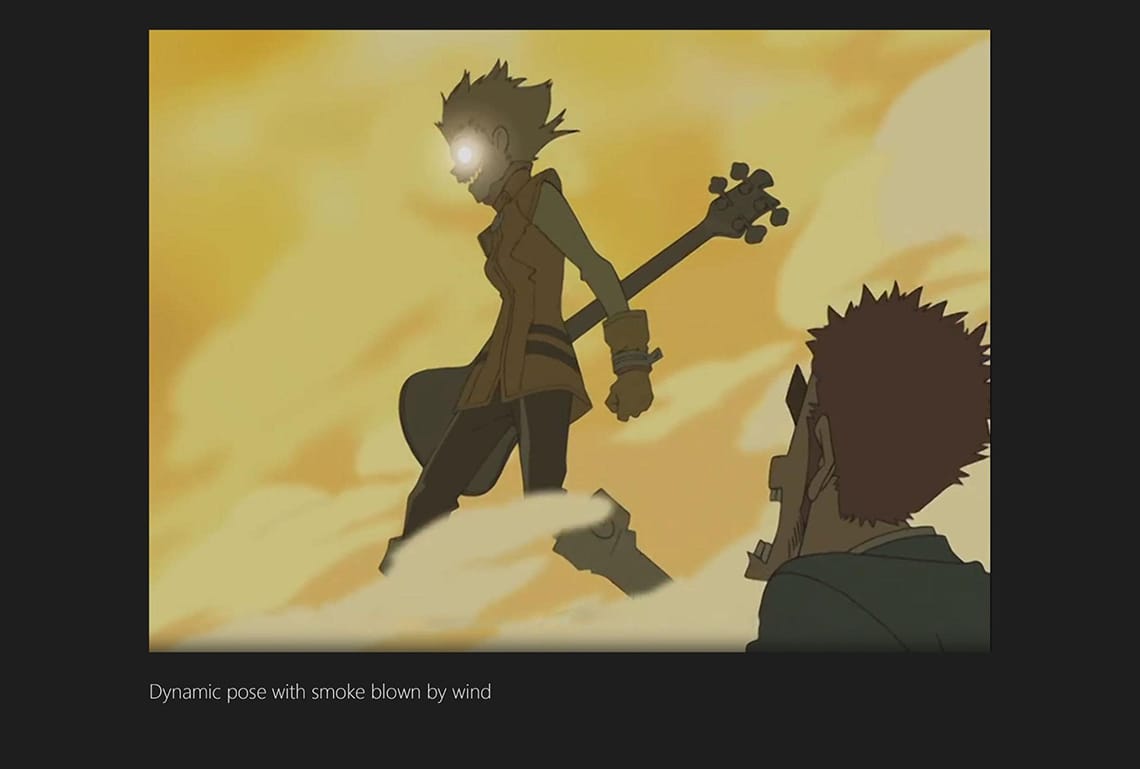
Finally, I decided on the road shoulder but with night lighting. I also added some more references to my PureRef board.
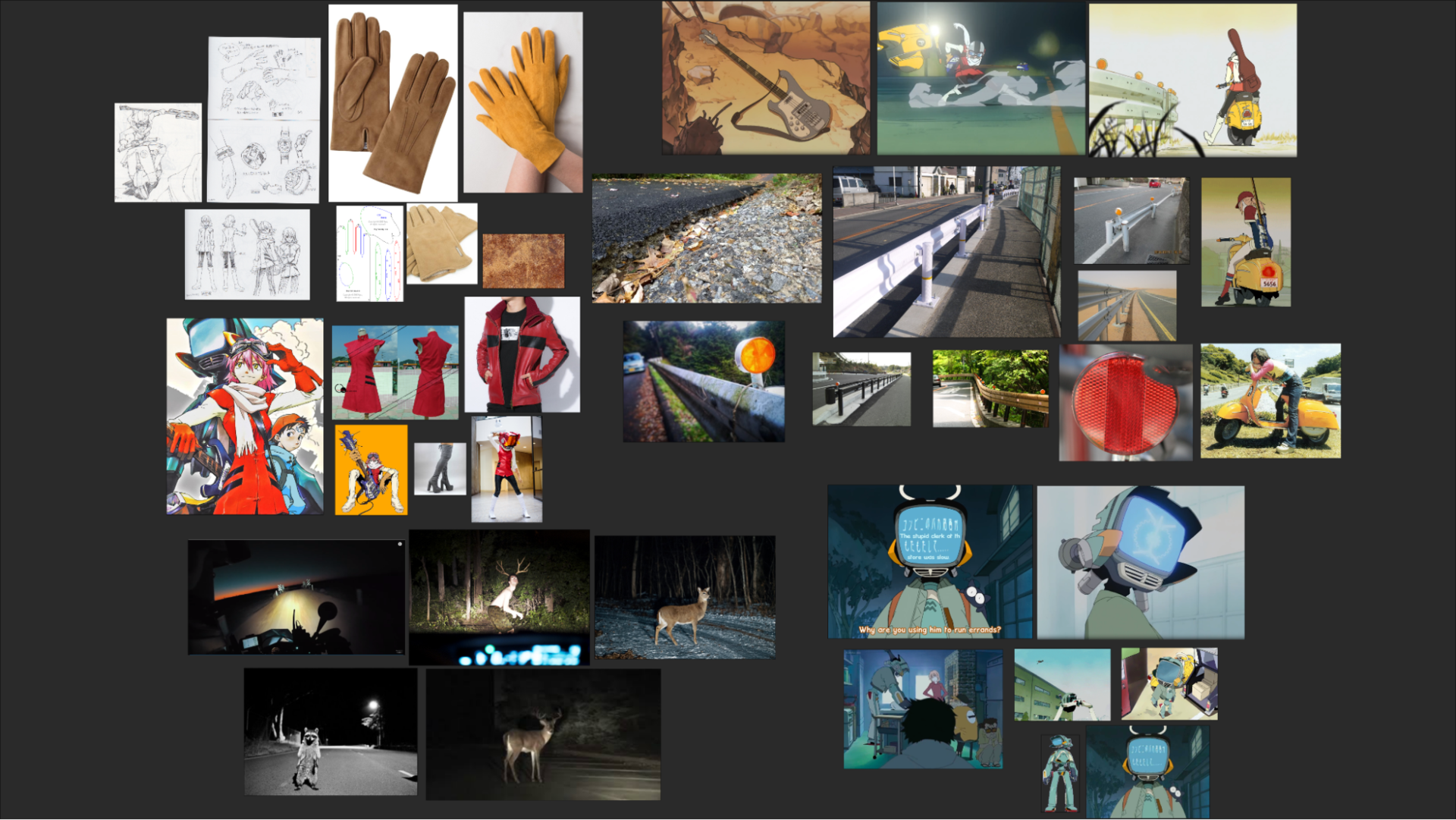
At the same time, I started blocking out the composition.
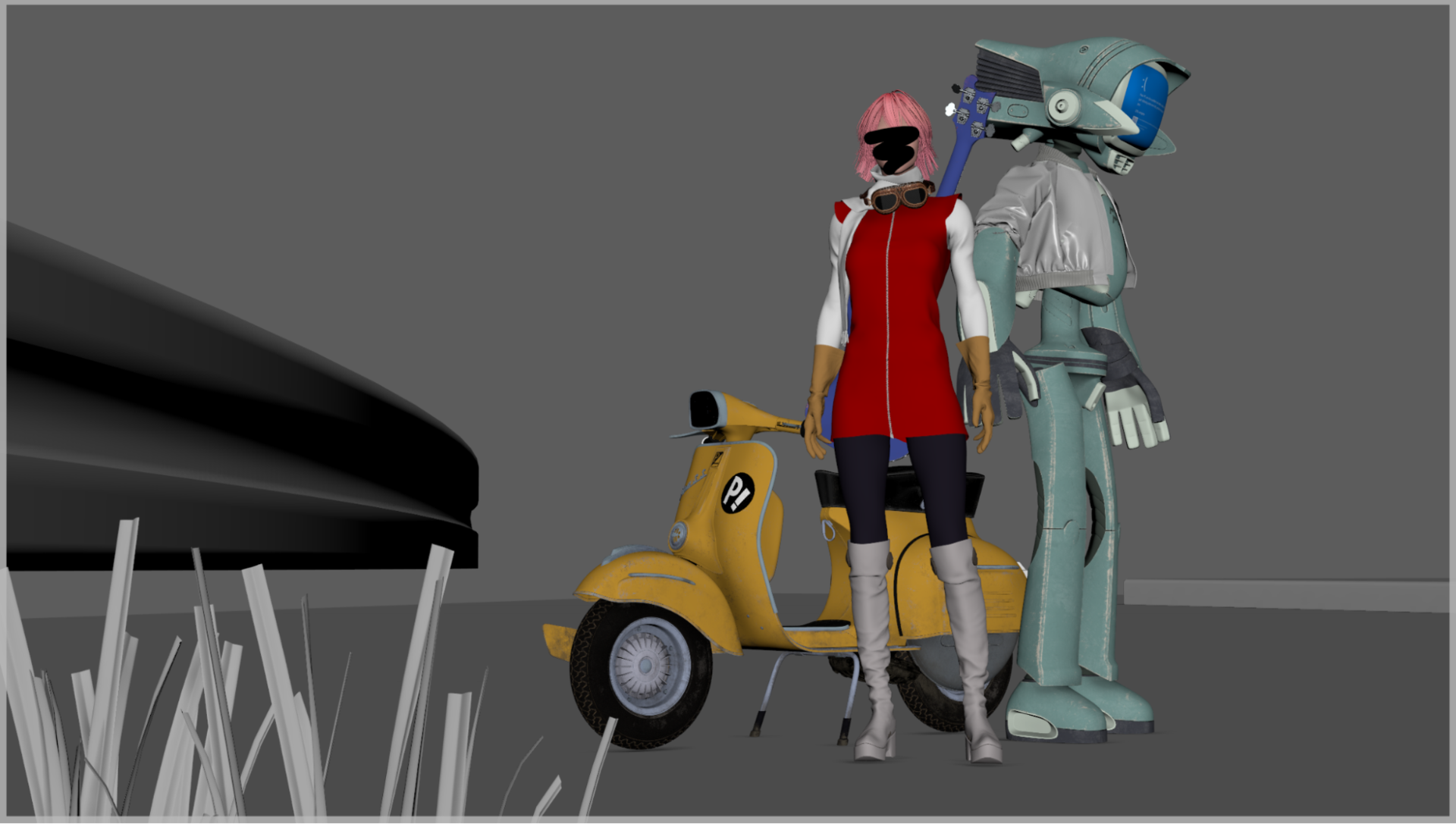
Fun fact: The grass in the foreground block-out is actually a procedural script I made for Zephyr Mann’s Expressions and Scripting class.
Modeling in Maya and Zbrush
During the 10 weeks of the course, I had to touch-up my old models and make an environment for the characters, so I tried to evenly progress each model and set everything up and render as soon as possible.
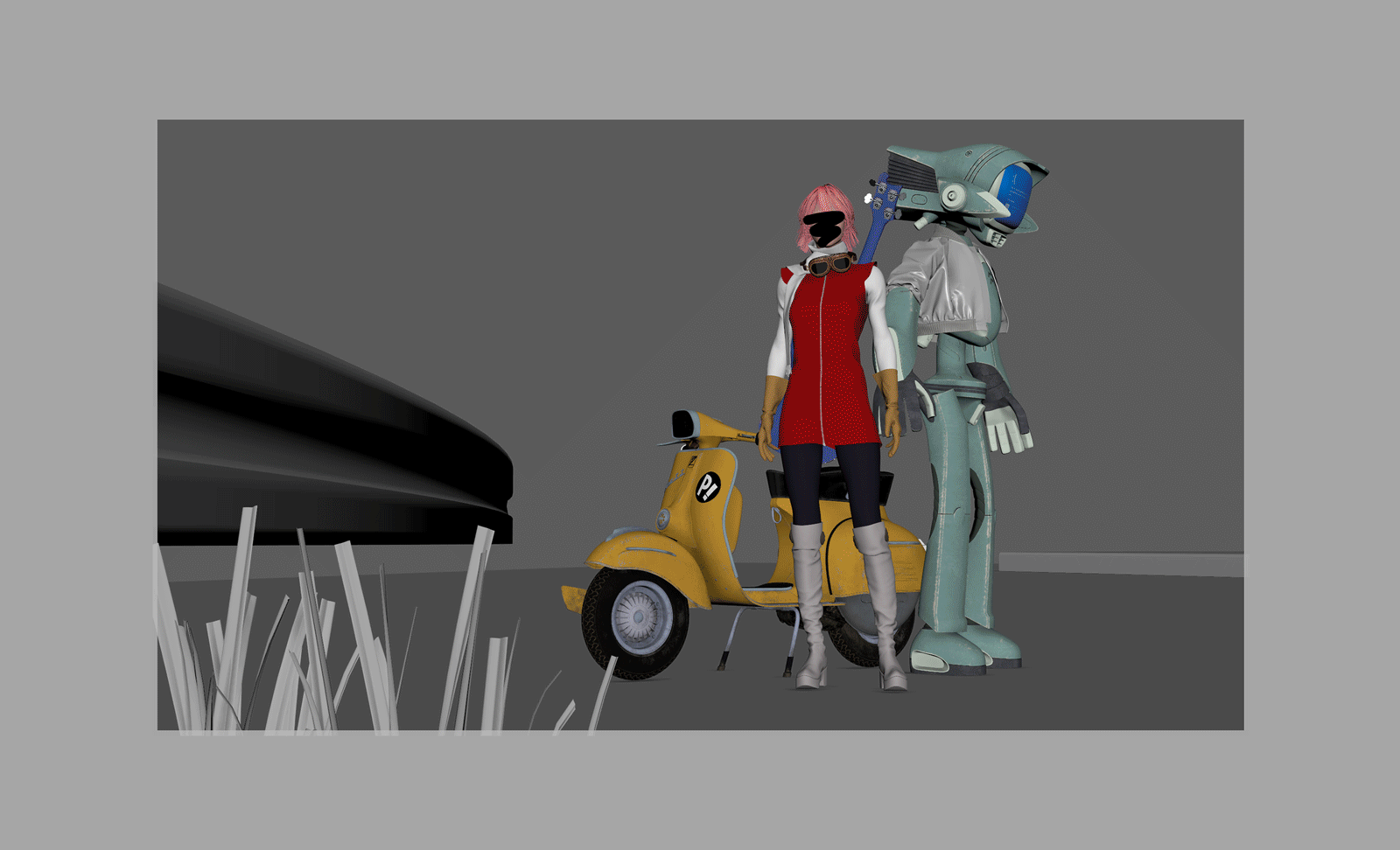
Usually I start in Maya to set the scale and start the initial block-out. For hard-surface objects I stay in Maya most of the time and jump into Zbrush to model organic shapes if needed. On Canti, I used Zbrush to sculpt connecting pieces on his neck and ankles.
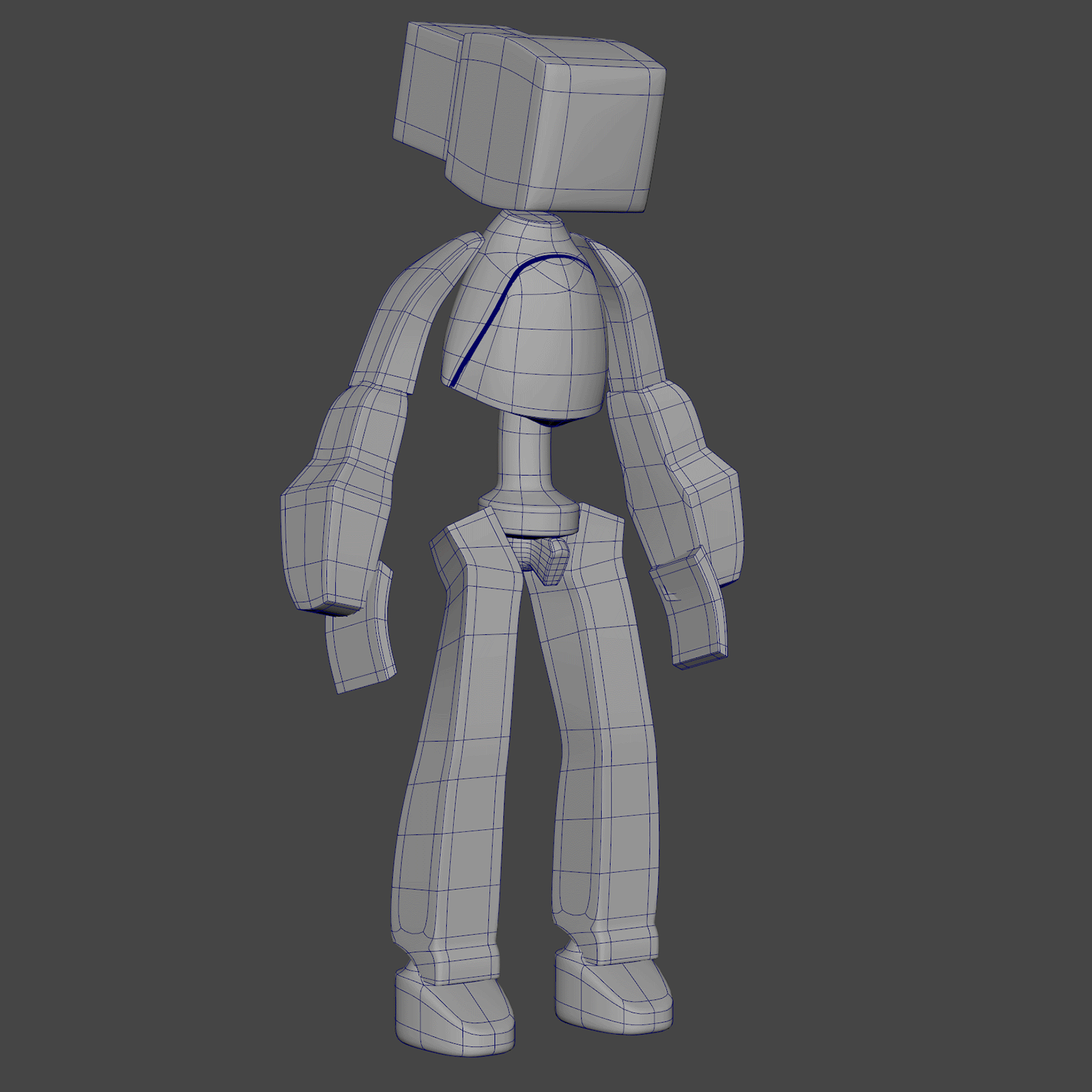
For the Vespa, I only sculpted some folds on the seat in Zbrush; everything else was modeled in Maya.
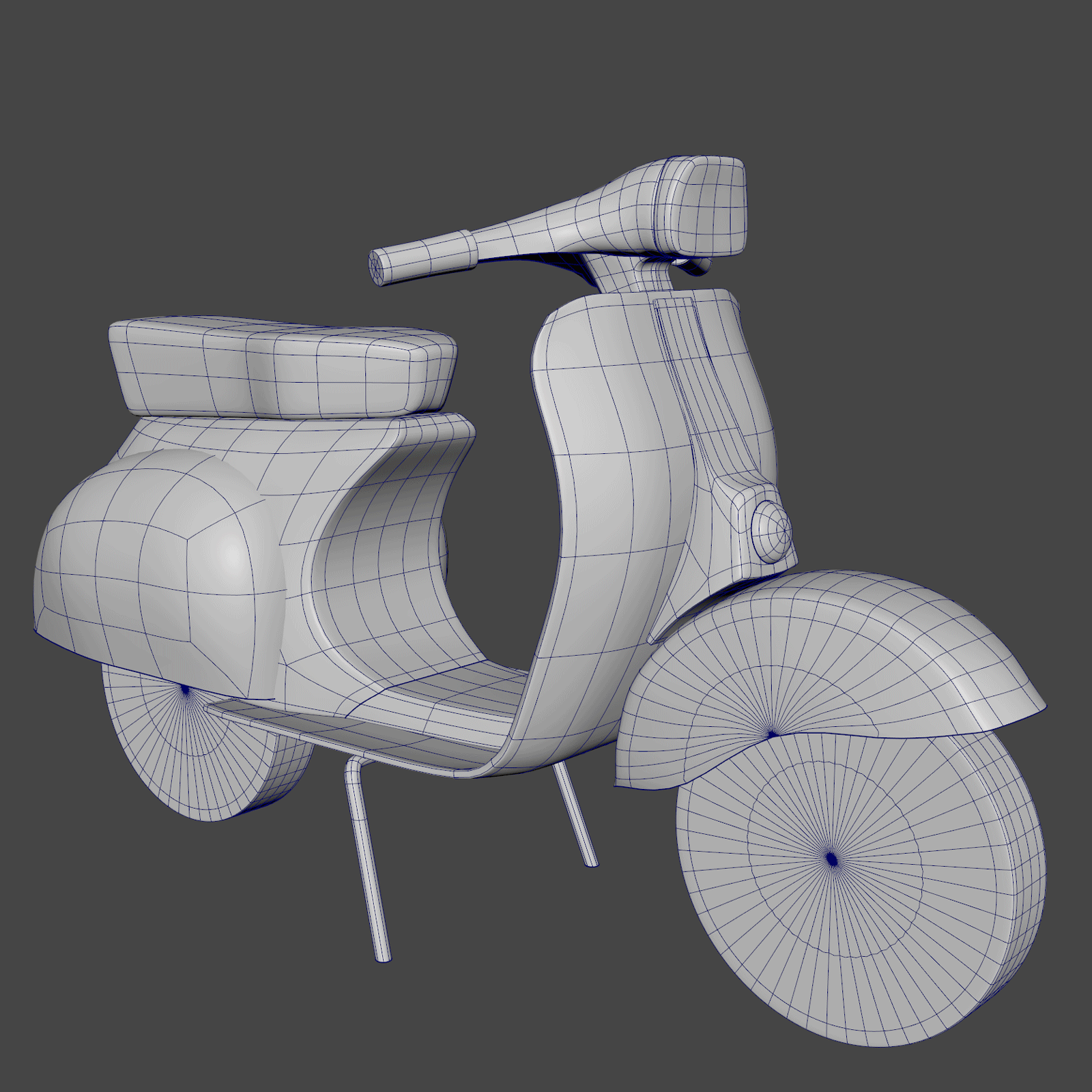
If I modeled for higher resolution, I would do a Zbrush pass on subdivided models to add some extra damage and bake a normal/displacement map. For this project, I just painted some scratches in Substance since I wasn’t planning any super-close-up renders.
For Haruko, I used Maya for scale block-in, but most sculpting was done in Zbrush. I used Maya for occasional topology adjustments. I prefer clean topology for sculpting and it saves time later if you need to retopologize.
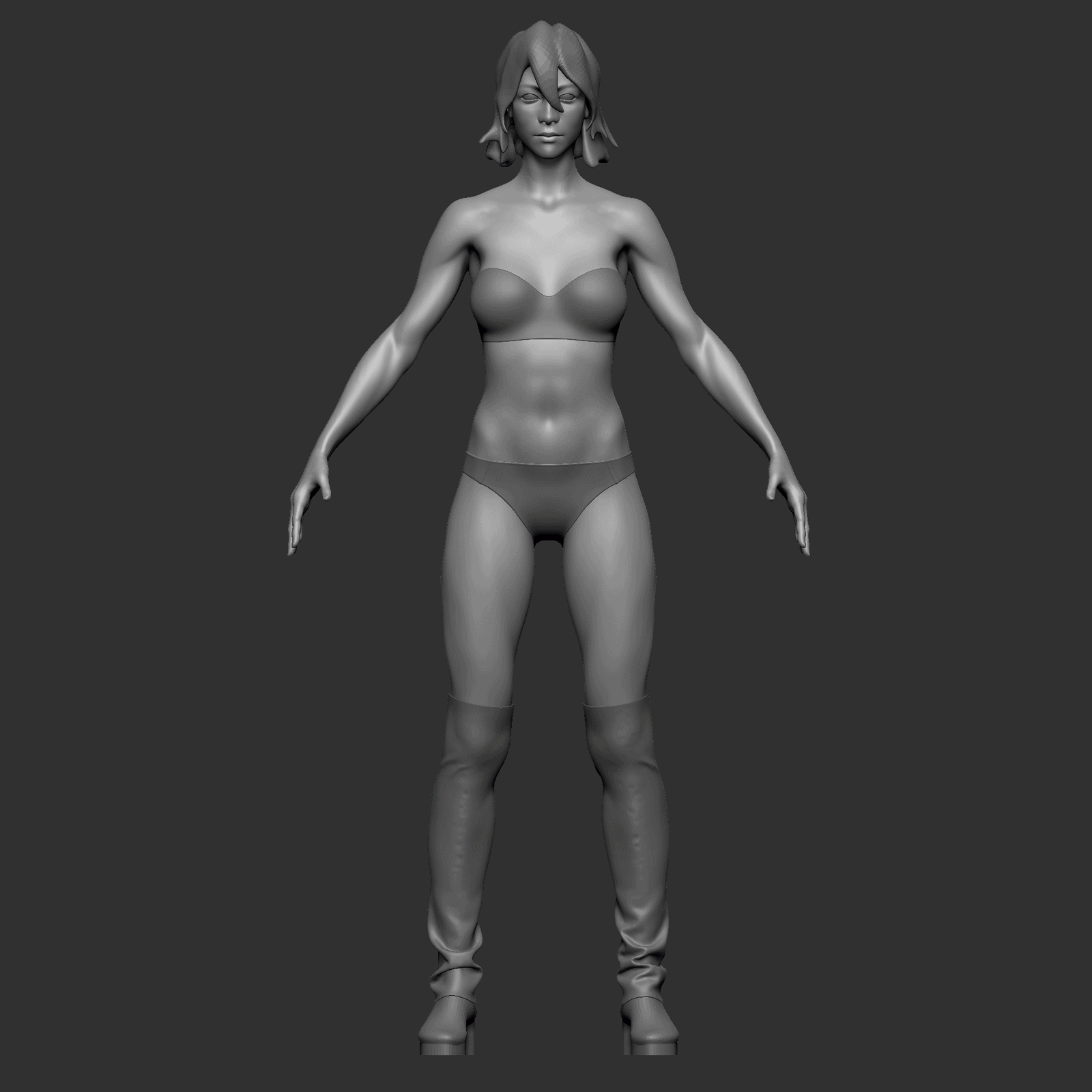
I initially made Haruko’s Rickbacker entirely in ZBrush because it was for an Intro to ZBrush class and I didn’t know Maya back then. But I updated the model for this project, using optimized topology and UVs.
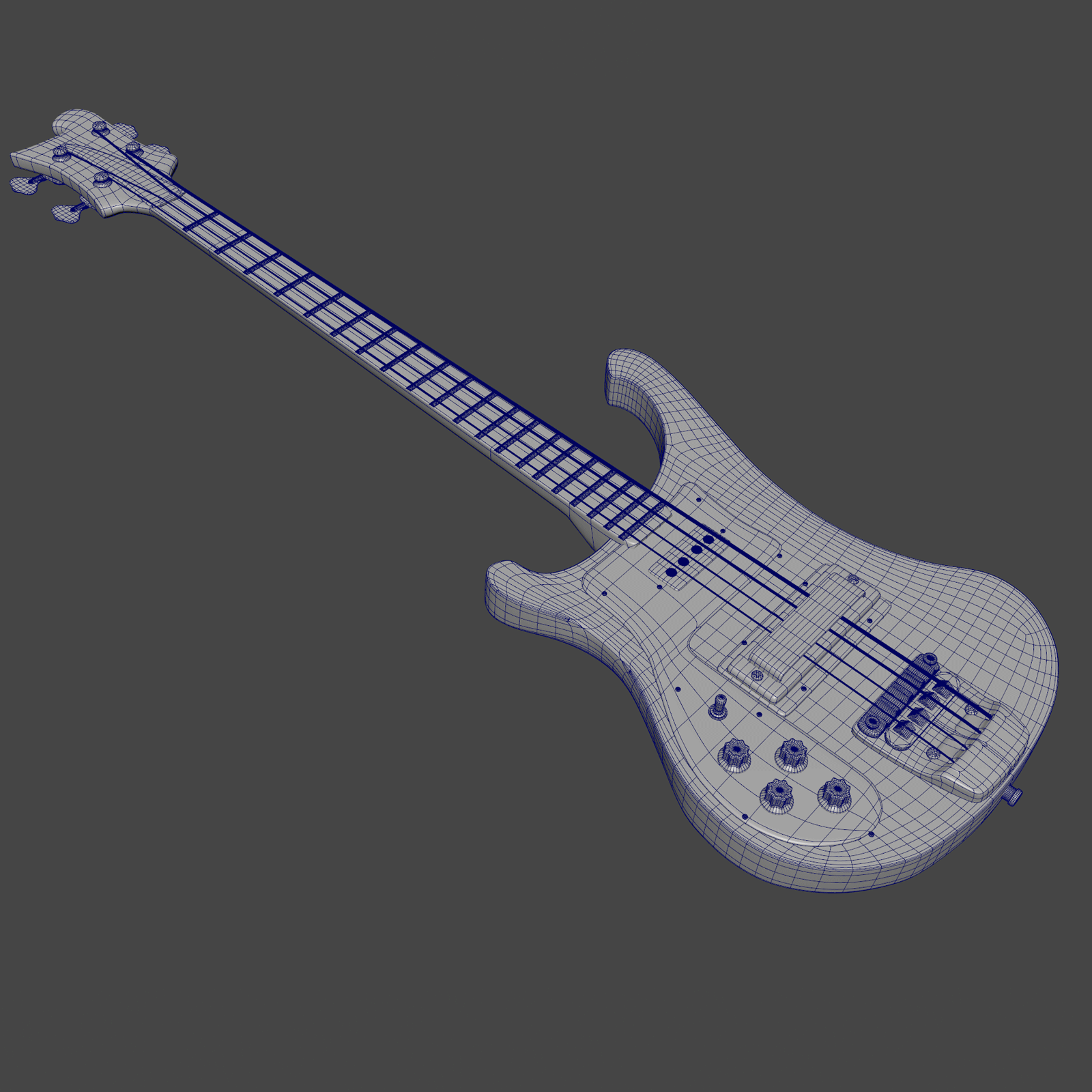
V-Ray Render Elements and V-Ray Layers
I used Substance Painter to texture all the models. For Haruko’s face I used Female 30s Multichannel Face #07 from Texturing.xyz and used this Photoshop workflow to quickly apply albedo and displacement maps.
Because my plan was to render full figures (not close-up) with night lighting, I textured them keeping that in mind. For a single shot like this, it was important to fit in our weekly deadlines.
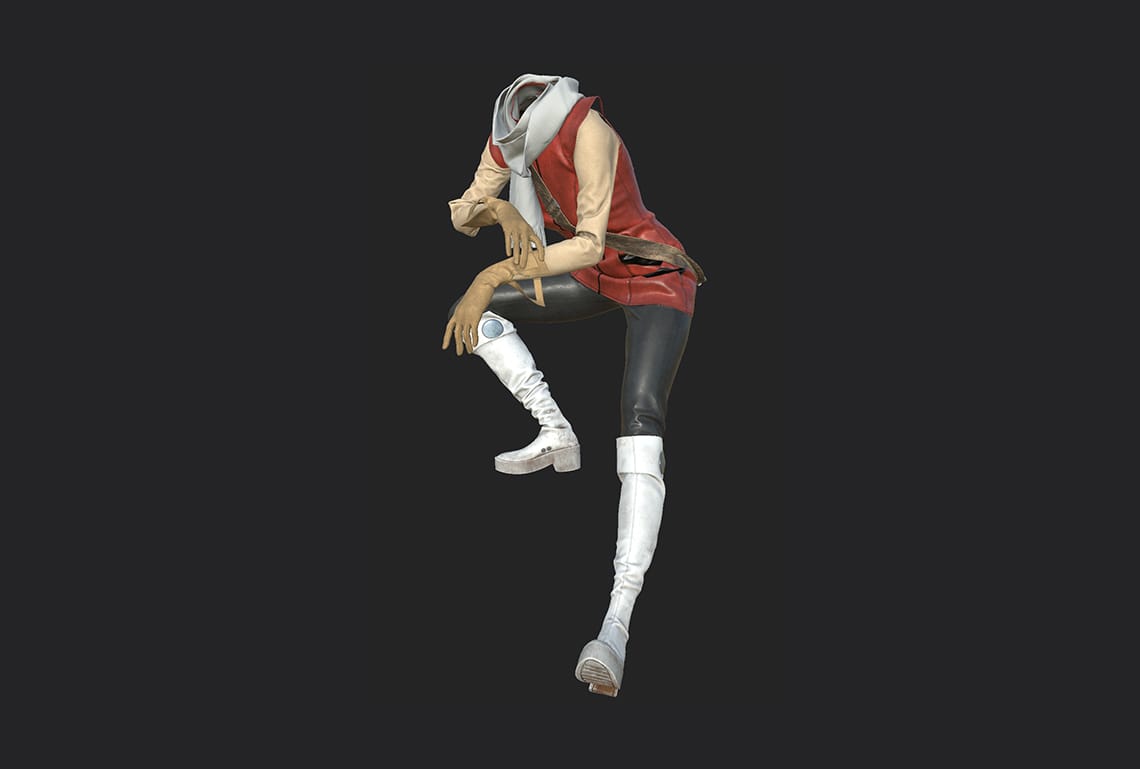
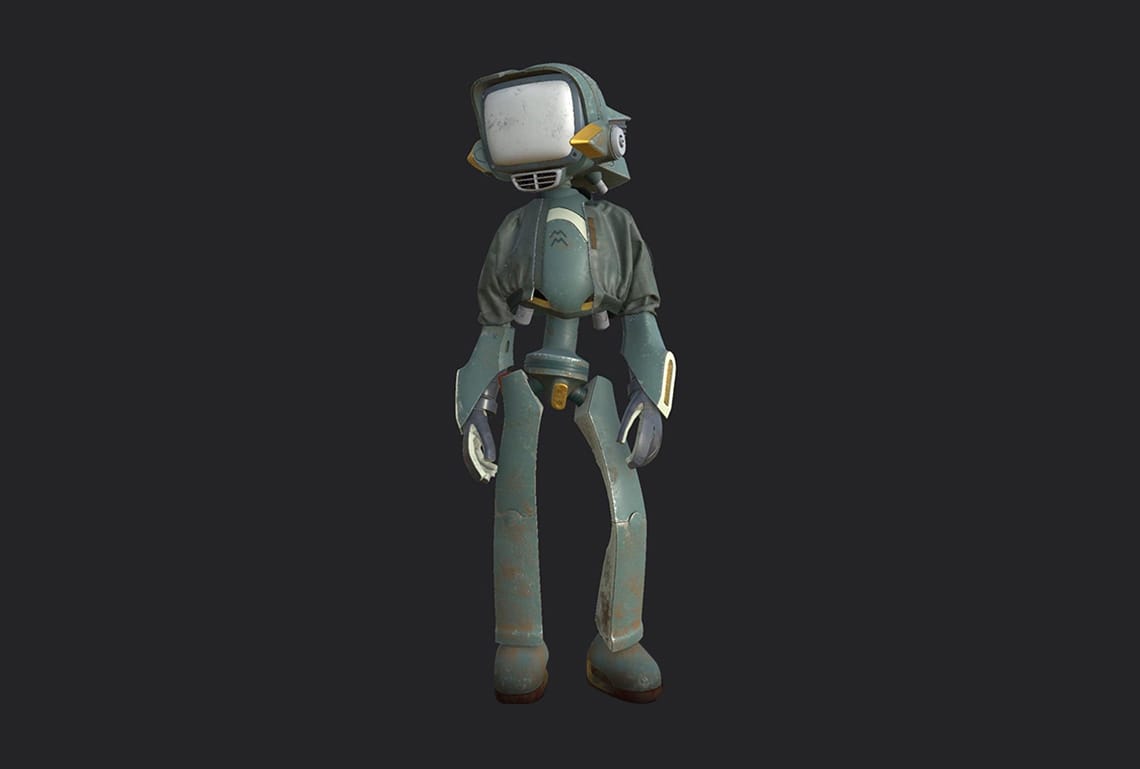
All materials were made for rendering in V-Ray except for the Vespa, but it was very easy to convert that to V-Ray too, by plugging in the maps and inverting the Roughness Map to use as Glossiness.
Camera setup and final composition
It can take a lifetime to learn how to create a powerful and engaging composition. If I dare to summarize what I learned over the years of trying to study it: just slap a Golden Spiral on it. Works like a charm.
Hot tip: Use Photoshop’s built-in overlays in the Crop tool to check with different types of composition rules: Golden Ratio, Golden Spiral, Rule of Thirds, etc.
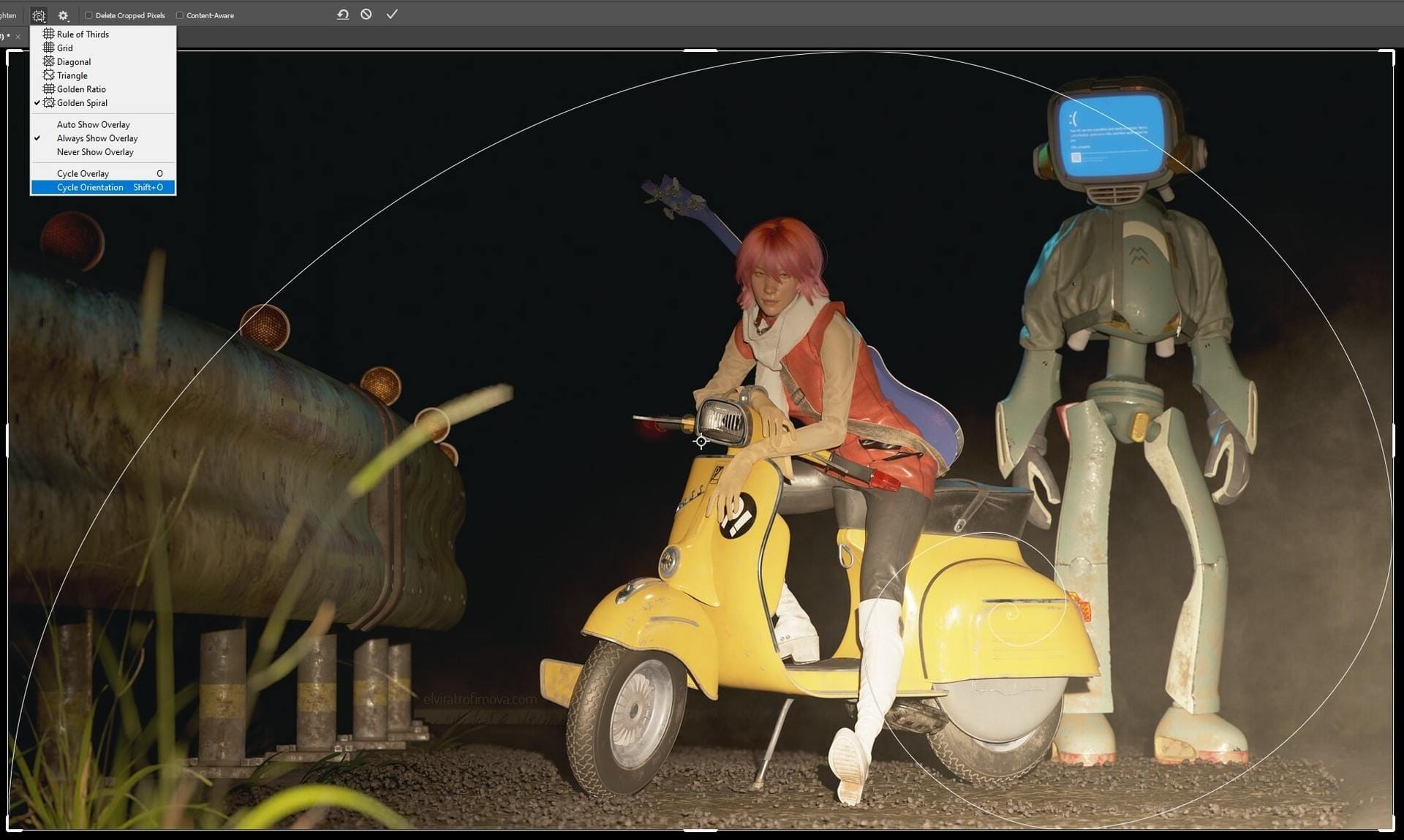
Another composition tip is to try and avoid visual tangents. That’s pretty much the main two things that I try to balance when moving things around.
For the main render camera, I only changed Focal Length to 90mm. I tend to like medium telephoto lens look, depending on the situation from 50 to 200 mm.
Lighting and camera
I wanted to try the “deer in the headlight” type of lighting in one of my works and finally got a good opportunity to explore that for my FLCL crew. I tried different combinations with added rim lights and distant lights but I think the best effect for this look was achieved with just one main source: V-Ray Rectangle light close to the render camera with HDR texture of an actual bike headlight (found at hdrlabs under Lightsmith Collection).
I have one V-Ray Dome light in the scene with Night HDR at very low intensity just in case it might be visible in reflections. I also added V-Ray Sphere and Rectangle lights for the Vespa’s headlight, backlight, turn signals and Canti’s screen. I rendered them with the Light Select Render Element and animated separately in Nuke.
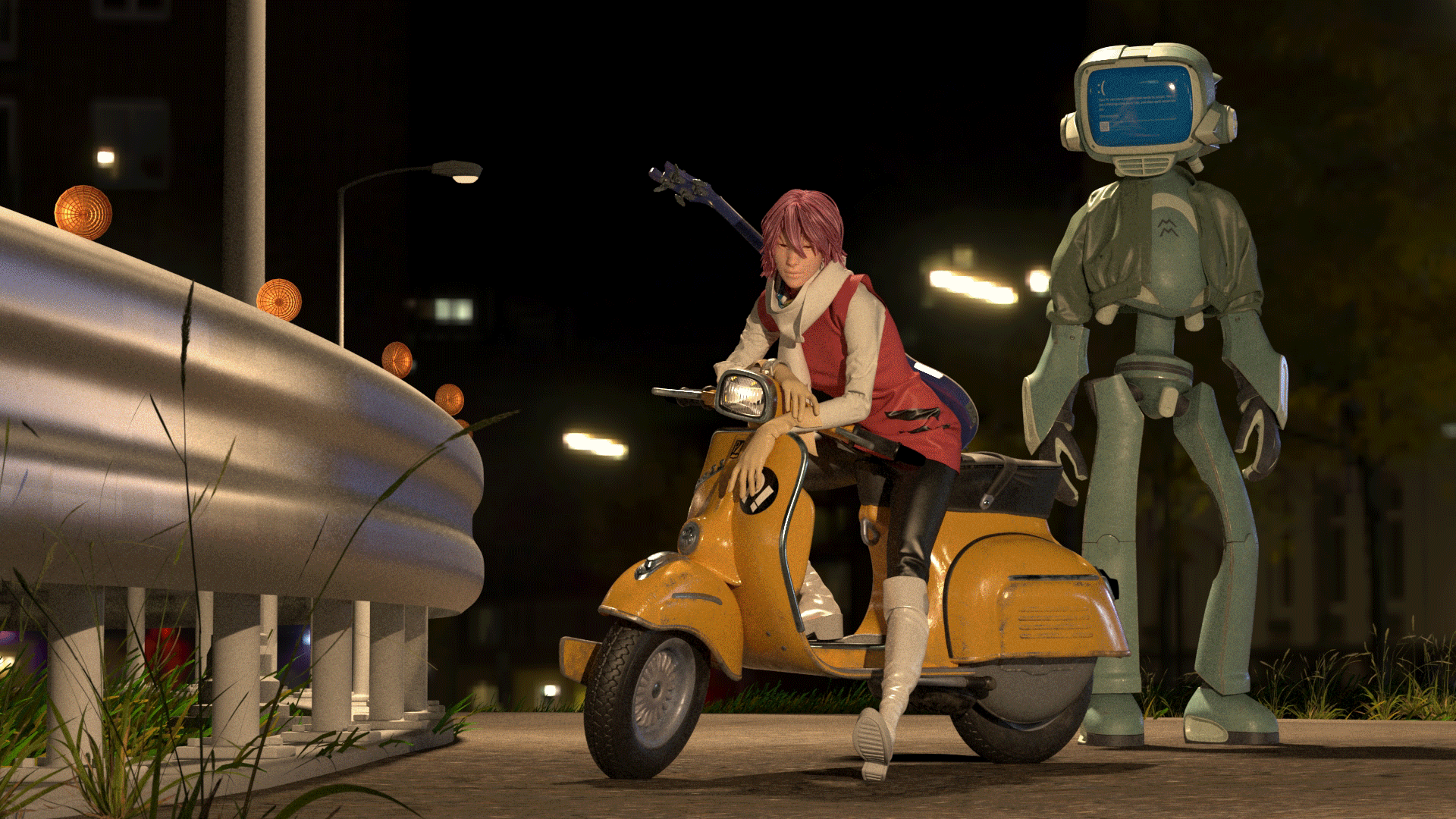
Render elements and layers
Because that project was made for Look Development class I’ve learned a lot of new tricks for rendering. For example, the more Render Elements, the merrier. Separating the passes gives me greater control for post-production later.
The most mind-blowing in terms of post-production control I think are Z-Depth and Light Select. It takes a lot of time to render depth of field if you just bake it in but it takes away the flexibility of adjusting it later. The Z-Depth pass gives the ability to control depth and level of blur and can also be animated. Same with Light Select — you can adjust intensity for each individual light source or turn it off, or, like I did in my case - animate them!
I had two render layers — one with characters and environment and another with foreground foliage. For each render layer, I saved all render elements into their own single .exr files.
Post-production
For post-production we used Nuke. First we needed to separate render elements we want to control with a Shuffle node and name them accordingly. Then merge them back together with Merge nodes on Plus.
I added glow to the lights for an atmospheric effect. With Transform node I animated slight zoom in on the main render and offset zoom in on the foliage render for a parallax effect. I added flickering to Canti’s screen with NoiseCurve node, value set to random. I added a sine curve to the Mix parameter of the node that merges Vespa’s signal and back lights and keyed the main headlight mix manually (turn on, fade out). Finally I added LUT corrector with the Vectorfield node to bring image from raw to sRGB gamma.
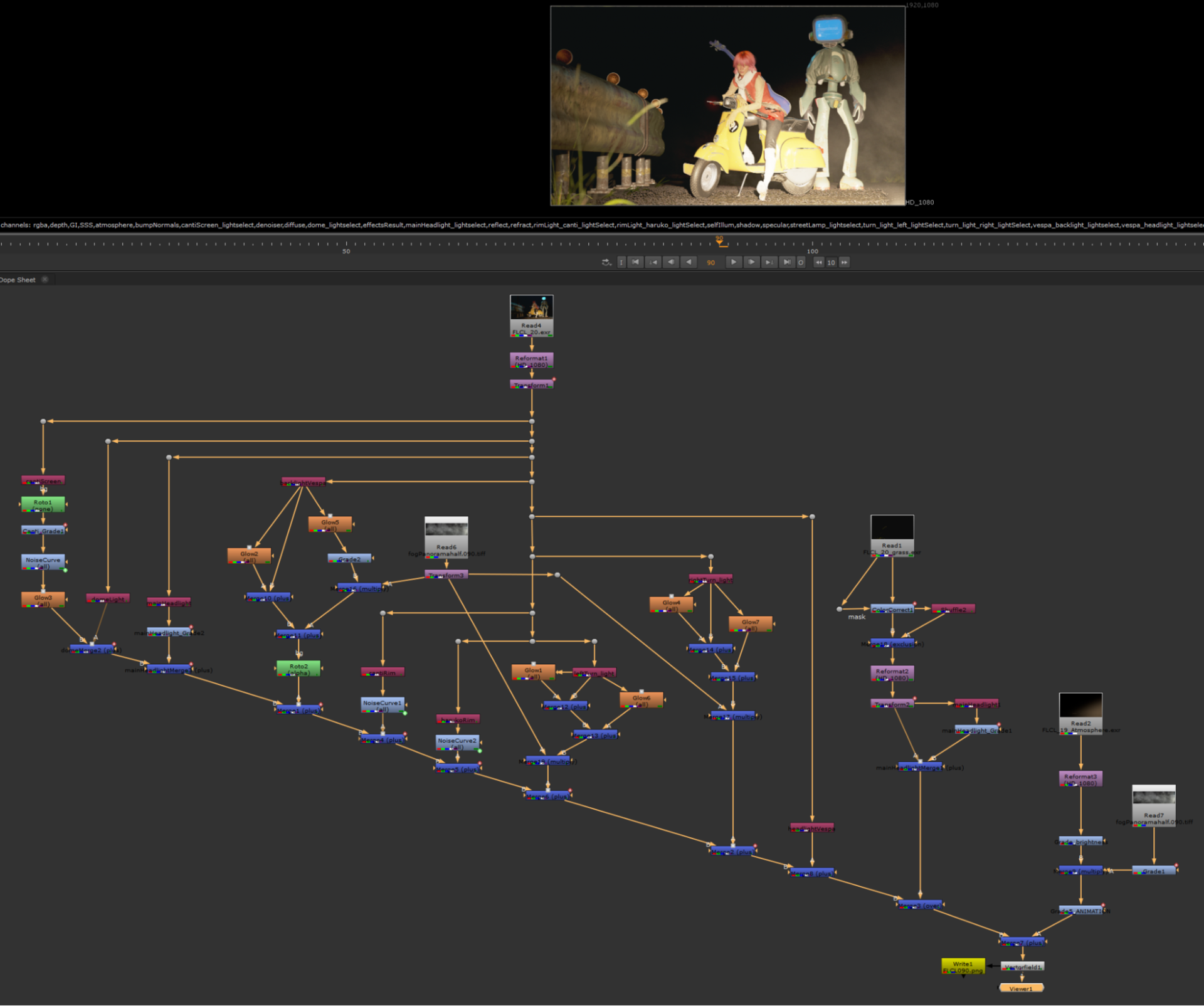
The final output was rendered as a 180-frame .png sequence at 24 fps and was combined into a video format in Adobe After Effects.
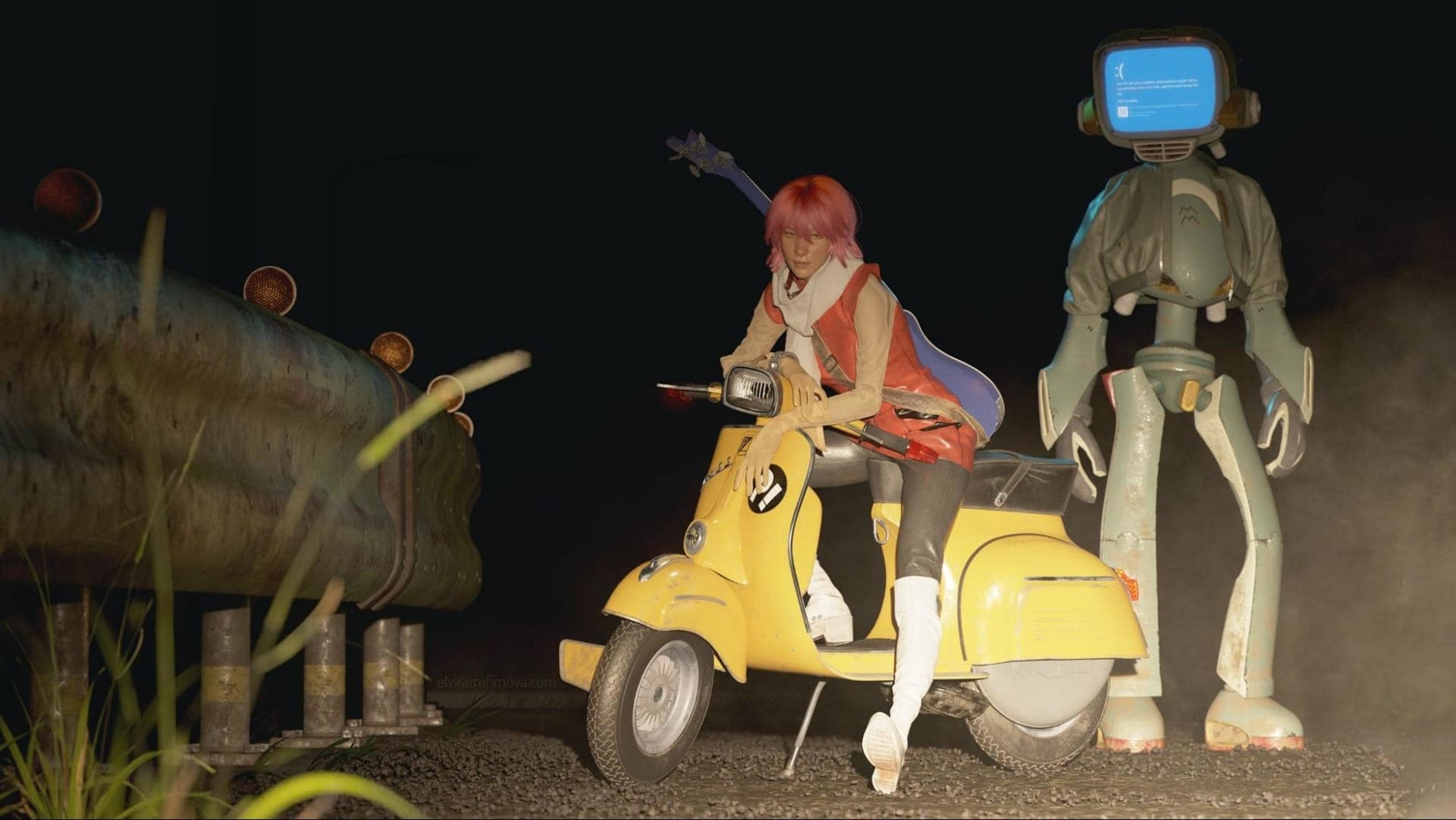
The takeaway
One of the main things I learned in FLCL crew, and similar projects made for offline rendering, is to set up and render the composition as soon as possible and adjust based on that. You can infinitely finesse little details on your model, but if the project calls for one shot and those little details are not even visible in the shot you should skip fine detailing work on them! Look at the composition and see what actually needs improvement. You should focus on pinpointing the selling point, and use shortcuts to add the rest.
Keep in mind, though, that this approach is not applicable for production work that requires close-up shots and different lighting scenarios, just for small personal shots like the ones I created.
If I had more time, I would work to perfect the materials and hair, but with the time constraints of a 10-week class, I think the project proved to be a successful exercise. It was a great way to learn new things about Look Development and combine that with my passion for the FLCL characters.
This project would not have been possible without the help of my amazing Gnomon instructors, Miguel Ortega and Anton Napierala, my husband Alex who supported me throughout the two years of studying, and our cat Musya for providing the best emotional support.
Finally, thanks to Chaos for the opportunity to share my artistic process and inspire others with what I love!
Render robots that spark fascination.
Try V-Ray for Maya free for 30 days.
Related articles
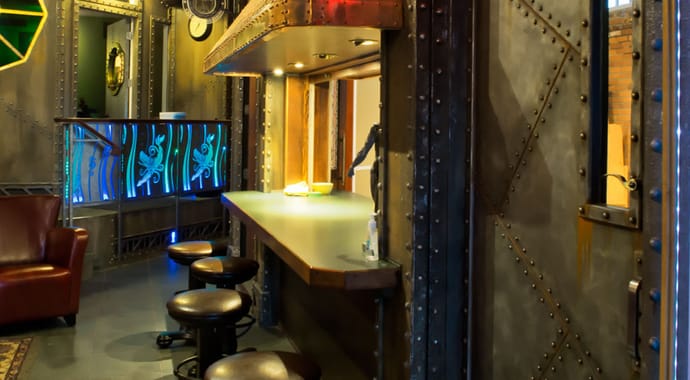 © Think Tank
© Think TankHow V-Ray fuels creativity in Think Tank students
Think Tank is a world class training centre for feature film, video game, and television production.
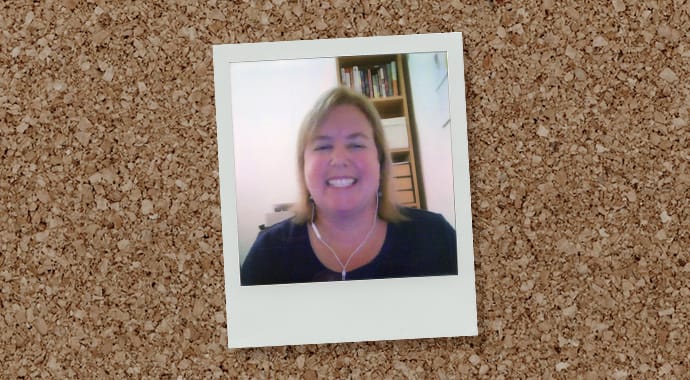
Shannon Wiggins — Director of Placement & Alumni Relations, Gnomon School of Visual Effects
Gnomon doesn’t just teach students VFX — it also gets them jobs at illustrious studios. Meet Shannon Wiggins, the woman behind the school’s 97% placement rate.
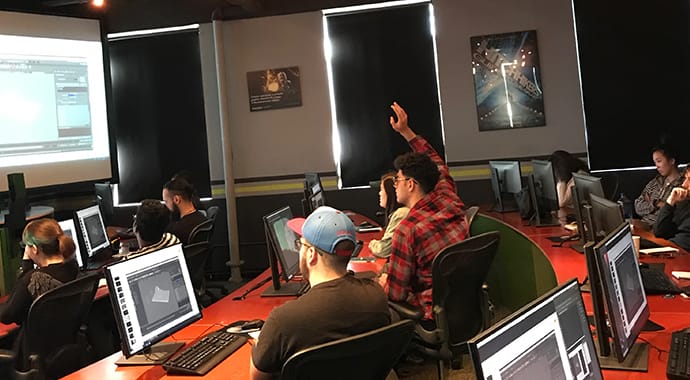
V-Ray Next for Maya secrets revealed at Gnomon School
Agents of Chaos flew to California this summer to share with Gnomon students how an efficient V-Ray Next for Maya workflow can make them even better artists.
 © Škoda Design
© Škoda DesignSubscribe to our blog.
Get the latest news, artist spotlight stories, tips and tricks delivered to your inbox.
By submitting your information you are agreeing to receive marketing messages from Chaos. You can opt-out at any time. Privacy Policy.



